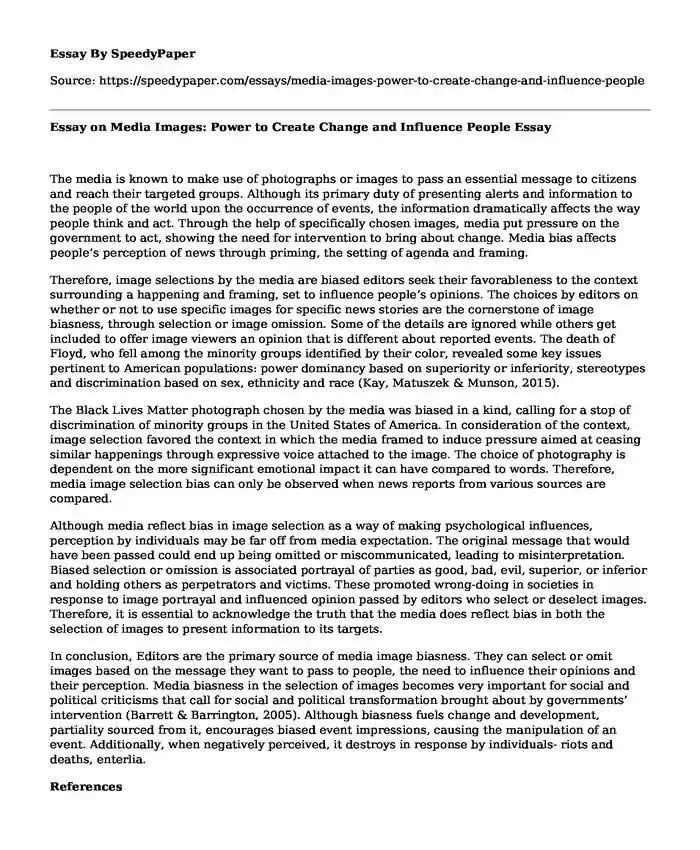The media is known to make use of photographs or images to pass an essential message to citizens and reach their targeted groups. Although its primary duty of presenting alerts and information to the people of the world upon the occurrence of events, the information dramatically affects the way people think and act. Through the help of specifically chosen images, media put pressure on the government to act, showing the need for intervention to bring about change. Media bias affects people’s perception of news through priming, the setting of agenda and framing.
Therefore, image selections by the media are biased editors seek their favorableness to the context surrounding a happening and framing, set to influence people’s opinions. The choices by editors on whether or not to use specific images for specific news stories are the cornerstone of image biasness, through selection or image omission. Some of the details are ignored while others get included to offer image viewers an opinion that is different about reported events. The death of Floyd, who fell among the minority groups identified by their color, revealed some key issues pertinent to American populations: power dominancy based on superiority or inferiority, stereotypes and discrimination based on sex, ethnicity and race (Kay, Matuszek & Munson, 2015).
The Black Lives Matter photograph chosen by the media was biased in a kind, calling for a stop of discrimination of minority groups in the United States of America. In consideration of the context, image selection favored the context in which the media framed to induce pressure aimed at ceasing similar happenings through expressive voice attached to the image. The choice of photography is dependent on the more significant emotional impact it can have compared to words. Therefore, media image selection bias can only be observed when news reports from various sources are compared.
Although media reflect bias in image selection as a way of making psychological influences, perception by individuals may be far off from media expectation. The original message that would have been passed could end up being omitted or miscommunicated, leading to misinterpretation. Biased selection or omission is associated portrayal of parties as good, bad, evil, superior, or inferior and holding others as perpetrators and victims. These promoted wrong-doing in societies in response to image portrayal and influenced opinion passed by editors who select or deselect images. Therefore, it is essential to acknowledge the truth that the media does reflect bias in both the selection of images to present information to its targets.
In conclusion, Editors are the primary source of media image biasness. They can select or omit images based on the message they want to pass to people, the need to influence their opinions and their perception. Media biasness in the selection of images becomes very important for social and political criticisms that call for social and political transformation brought about by governments’ intervention (Barrett & Barrington, 2005). Although biasness fuels change and development, partiality sourced from it, encourages biased event impressions, causing the manipulation of an event. Additionally, when negatively perceived, it destroys in response by individuals- riots and deaths, enterlia.
References
Barrett, A. W., & Barrington, L. W. (2005). Bias in newspaper photograph selection. Political Research Quarterly, 58(4), 609-618.
Kay, M. Matuszek, C., & Munson, S. A. (2015). Unequal representation and gender stereotypes in image search results for occupations. In Proceedings of 33rd Annual ACM Conference on human factors in computing systems, pp 3819-3828. 2015
Cite this page
Essay on Media Images: Power to Create Change and Influence People. (2023, Oct 29). Retrieved from https://speedypaper.net/essays/media-images-power-to-create-change-and-influence-people
Request Removal
If you are the original author of this essay and no longer wish to have it published on the SpeedyPaper website, please click below to request its removal:
- Media Culture Essay Example
- Concert Review Essay Example - Music of Our Time Concert
- Movies Review Essay Sample
- Essay Example on Global Trends in Netflix Company
- Free Essay Sample on Alexander the Great
- Media Bias and Ideologies - Free Paper Example
- Free Paper on Social Media and Protests: The Power to Mobilize, Inform, and Shape Change
Popular categories





